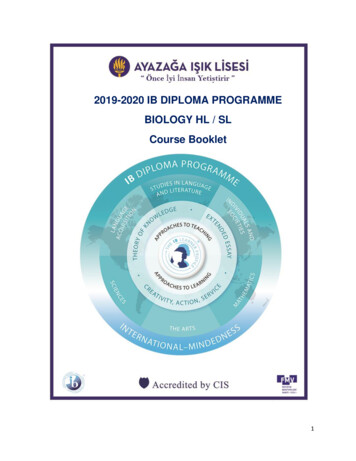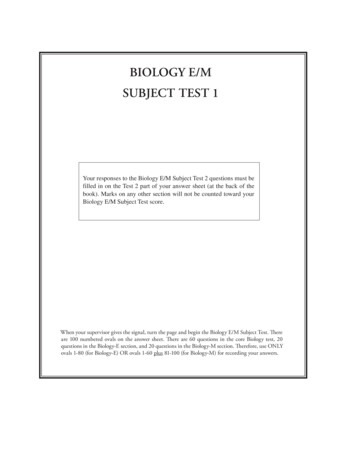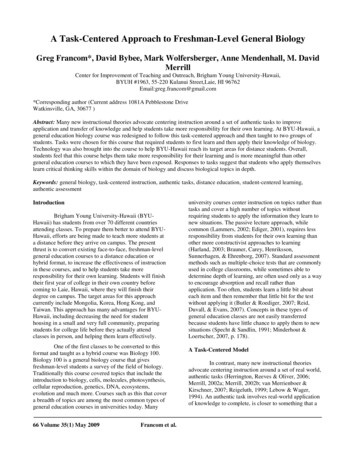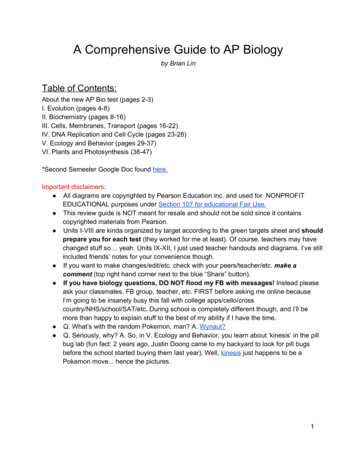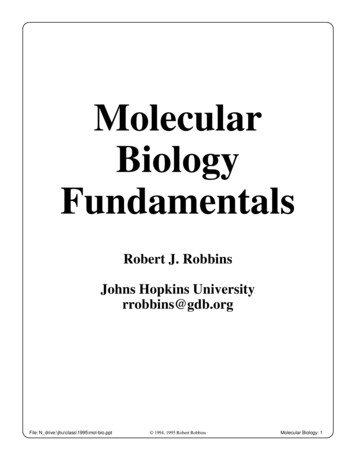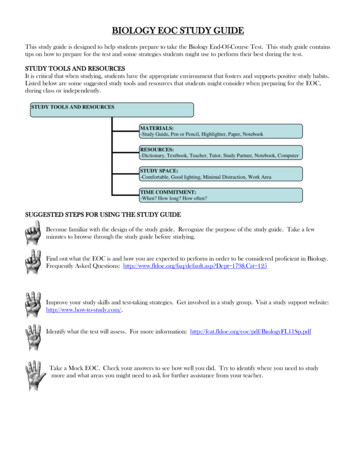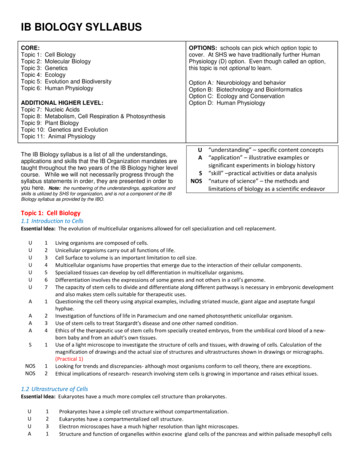
Transcription
IB BIOLOGY SYLLABUSCORE:Topic 1:Topic 2:Topic 3:Topic 4:Topic 5:Topic 6:Cell BiologyMolecular BiologyGeneticsEcologyEvolution and BiodiversityHuman PhysiologyADDITIONAL HIGHER LEVEL:Topic 7: Nucleic AcidsTopic 8: Metabolism, Cell Respiration & PhotosynthesisTopic 9: Plant BiologyTopic 10: Genetics and EvolutionTopic 11: Animal PhysiologyThe IB Biology syllabus is a list of all the understandings,applications and skills that the IB Organization mandates aretaught throughout the two years of the IB Biology higher levelcourse. While we will not necessarily progress through thesyllabus statements in order, they are presented in order toyou here. Note: the numbering of the understandings, applications andskills is utilized by SHS for organization, and is not a component of the IBBiology syllabus as provided by the IBO.OPTIONS: schools can pick which option topic tocover. At SHS we have traditionally further HumanPhysiology (D) option. Even though called an option,this topic is not optional to learn.Option A:Option B:Option C:Option D:Neurobiology and behaviorBiotechnology and BioinformaticsEcology and ConservationHuman PhysiologyU “understanding” – specific content conceptsA “application” – illustrative examples orsignificant experiments in biology historyS “skill” –practical activities or data analysisNOS “nature of science” – the methods andlimitations of biology as a scientific endeavorTopic 1: Cell Biology1.1 Introduction to CellsEssential Idea: The evolution of multicellular organisms allowed for cell specialization and cell replacement.UUUUUUU1234567A1AAA234S1NOSNOS12Living organisms are composed of cells.Unicellular organisms carry out all functions of life.Cell Surface to volume is an important limitation to cell size.Multicellular organisms have properties that emerge due to the interaction of their cellular components.Specialized tissues can develop by cell differentiation in multicellular organisms.Differentiation involves the expressions of some genes and not others in a cell’s genome.The capacity of stem cells to divide and differentiate along different pathways is necessary in embryonic developmentand also makes stem cells suitable for therapeutic uses.Questioning the cell theory using atypical examples, including striated muscle, giant algae and aseptate fungalhyphae.Investigation of functions of life in Paramecium and one named photosynthetic unicellular organism.Use of stem cells to treat Stargardt’s disease and one other named condition.Ethics of the therapeutic use of stem cells from specially created embryos, from the umbilical cord blood of a newborn baby and from an adult’s own tissues.Use of a light microscope to investigate the structure of cells and tissues, with drawing of cells. Calculation of themagnification of drawings and the actual size of structures and ultrastructures shown in drawings or micrographs.(Practical 1)Looking for trends and discrepancies- although most organisms conform to cell theory, there are exceptions.Ethical implications of research- research involving stem cells is growing in importance and raises ethical issues.1.2 Ultrastructure of CellsEssential Idea: Eukaryotes have a much more complex cell structure than prokaryotes.UUUA1231Prokaryotes have a simple cell structure without compartmentalization.Eukaryotes have a compartmentalized cell structure.Electron microscopes have a much higher resolution than light microscopes.Structure and function of organelles within exocrine gland cells of the pancreas and within palisade mesophyll cells
ASSSNOS21231of the leaf.Prokaryotes divide by binary fission.Drawings of the ultrastructure of prokaryotic cells based on electron micrographs.Drawings of the ultrastructure of eukaryotic cells based on electron micrographs.Interpretations of electron micrographs to identify organelles and deduce the function of specialized cells.Developments in scientific research follows improvements in apparatus- the invention of the electron microscopesled to greater understanding of cell structure.1.3 Membrane StructureEssential Idea: The structure of biological membranes makes them fluid and dynamic.UUUASSSNOSNOS123112312Phospholipids form bilayers in water due to the amphipathic properties of phospholipid molecules.Membrane proteins are diverse in terms of structure, position in the membranes and function.Cholesterol is a component of animal cell membranes.Cholesterol in mammalian membranes reduces membrane fluidity and permeability to some solutes.Drawing of the fluid mosaic model.Analysis of evidence from electron microscopy that led to the proposal of the Davidson-Danielli model.Analysis of the falsification of the Davison-Danielli model that led to the Singer-Nicolson model.Using models as representations of the real world-there are alternative models of membrane structures.Falsification of theories with one theory being superseded by another-evidence falsified the Davison-Danielli model.1.4 Membrane TransportEssential Idea: Membranes control the composition of cells by active and passive transport.UU12A1A2SNOS11Particles move across membranes by simple diffusion, facilitated diffusion, osmosis and active transport.The fluidity of membranes allows materials to be taken into cells by endocytosis or released by exocytosis. Vesiclesmove materials within cells.Structure and function of the sodium-potassium pumps for active transport and potassium channels for facilitateddiffusion in axons.Tissues or organs to be used in medical procedures must be bathed in a solution with the same osmolarity as thecytoplasm to prevent osmosis.Estimation of osmolarity in tissues by bathing samples in hypotonic and hypertonic solutions. (Practical 2)Experimental design- accurate quantitative measurements in osmosis experiments are essential.1.5 Origin of CellsEssential Idea: There is an unbroken chain of life from the first cells on Earth to all cells in organisms alive today.UUUA1231NOS1Cells can only be formed by division of pre-existing cells.The first cells must have arisen from non-living material.The origin of eukaryotic cells can be explained by the endosymbiotic theory.Evidence from Pastuer’s experiments that spontaneous generation of cells and organisms does not now occur onEarth.Testing the general principles that underline the natural world- the principles that cells only come from pre-existingcells needs to be verified.1.6 Cell DivisionEssential Idea: Cell division is essential but must be controlled.UUUUUUAS12345611Mitosis is division of the nucleus into two genetically identical daughter nuclei.Chromosomes condense by supercoiling during mitosis.Cytokinesis occurs after mitosis and is different in plants and animal cells.Interphase is a very active phase of the cell cycle with many processes occurring in the nucleus and cytoplasm.Cyclins are involved in the control of the cell cycle.Mutagens, oncogenes and metastasis are involved in the development of primary and secondary tumors.The correlation between smoking and incidence of cancers.Identification of phases of mitosis in cells viewed with a microscope or in a micrograph.
SNOS21Determination of a mitotic index from a micrograph.Serendipity and scientific discoveries- the discoveries of cyclins was accidental.Topic 2: Molecular Biology2.1 Molecules to MetabolismEssential Idea: Living Organisms control their composition by complex web of chemical reactions.UUUUU12345U6ASSNOS1121Molecular biology explains living processes in terms of the chemical substances involvedCarbon atoms can form four covalent bonds allowing a diversity of stable compounds to existLife is based on carbon compounds including carbohydrates, lipids proteins and nucleic acidsMetabolism is the web of all the enzyme-catalyzed reactions in a cell or organismAnabolism is the synthesis of complex molecules from simpler molecules including the formation of macromoleculesfrom monomers by condensation reactionsCatabolism is the breakdown of complex molecules into simpler molecules including the hydrolysis ofmacromolecules into monomersUrea as an example of a compound that is produced by living organisms but can also be artificially synthesizedDrawing molecular diagrams of glucose, ribose, a saturated fatty acid and a generalized amino acidIdentification of biochemical such as sugars, lipids, or amino acids from molecular drawingsFalsification of theories- the artificial synthesis of urea helped to falsify vitalism.2.2 WaterEssential Idea: Water is the medium of life.UUUAAA123123NOS1Water molecules are polar and hydrogen bonds form between them.Hydrogen bonding and dipolarity explain the cohesive, adhesive, thermal and solvent properties of water.Substances can be hydrophilic or hydrophobic.Comparison of the thermal properties of water with those of methane.Use of water as a coolant in sweat.Modes of transport of glucose, amino acids, cholesterol, fats. Oxygen, and sodium in blood in relations to theirsolubility in water.Use of theories to explain natural phenomena- the theory that hydrogen bonds form between water moleculesexplain the properties of water.2.3 Carbohydrates and LipidsEssential Idea: Compounds of carbon, hydrogen and oxygen are used to supply and store energy.U1UUUAAAASSNOS2341234121Monosaccharide monomers are linked together by condensation reactions to form disaccharides and polysaccharidepolymers.Fatty acids can be saturated, monounsaturated and polyunsaturated.Unsaturated fatty acids can be cis or trans isomers.Triglycerides are formed by condensation from three fatty acids and one glycerol.Structure and function of cellulose and starch in plants and glycogen in humans.Scientific evidence for health risks of trans fat and saturated fatty acids.Lipids are more suitable for long term energy storage in humans than carbohydrates.Evaluation of evidence and the methods used to obtain the evidence for health claims made about lipids.Use of molecular visualization software to compare cellulose, starch and glycogen.Determination of body mass index by calculation or use of a nomogram.Evaluating claims- health claims made about lipids in diets need to be assessed.2.4 ProteinsEssential Idea: Proteins have a very wide range of functions in living organisms.UUUU1234Amino Acids are linked together by condensation to form polypeptides.There are 20 different amino acids in polypeptides synthesized on ribosomes.Amino Acids can be linked together in any sequence giving a huge range of possible polypeptides.The amino acid sequence of polypeptides is coded for by genes.
UUUUAASNOS56781211A protein may consist of a single polypeptide or more than one polypeptide linked together.The amino acid sequence determines the three-dimensional conformation of a protein.Living organisms synthesize many different proteins with a wide range of functions.Every individual has a unique proteome.Rubisco, insulin immunoglobulins, rhodopsin, collagen and spider silk as examples of the range of protein functions.Denaturation of proteins by heat or by deviation of pH from the optimum.Drawing molecular diagrams to show the formation of a peptide bond.Looking for patterns, trends, and discrepancies- most but not all organisms assemble proteins from the same aminoacids.2.5 EnzymesEssential Idea: Enzymes control the metabolism of the cell.UUUUUASSNOS123451121Enzymes have an active site to which specific substrates bind.Enzyme catalysis involves molecular motion and the collision of substrates with the active site.Temperature, pH and substrate concentration affect the rate of activity of enzymes.Enzymes are denatured.Immobilized enzymes are widely used in industry.Methods of production of lactose-free milk and its advantages.Design of experiments to test the effect of temperature, pH, and substrate concentration on the activity of enzymes.Experimental investigation of a factor affecting enzyme activity. (Practical 3)Experimental design-accurate, quantitative measurements in enzyme experiments require replicates to ensurereliability.2.6 Structure of DNA and RNAEssential Idea: The structure of DNA allows efficient storage of genetic information.UUU123AS11NOS1The nucleic acids DNA and RNA are polymers of nucleotides.DNA differs from RNA in the number of strands present, the base composition and the type of pentose.DNA is double helix made of two antiparallel strands of nucleotides linked by hydrogen bonding betweencomplimentary base pairs.Crick and Watson’s elucidation of the structure of DNA using model making.Drawing simple diagrams of the structure of single nucleotides of DNA and RNA, using circles, pentagons, andrectangles to represent phosphates, pentoses and bases.Using models as representation of the real world- Crick and Watson used model making to discover the structure ofDNA.2.7 DNA Replications, Transcription and TranslationEssential Idea: Genetic information in DNA can be accurately copied and can be translated to make the proteins needed by the cell.UUUUUUUUAA1234567812SSS123SNOS41The replication of DNA is semi-conservative and depends on complimentary base pairing.Helicase unwinds the double helix and separates the two strands by breaking hydrogen bonds.DNA polymerase links nucleotides together to form a new strand, using a pre-existing strand as a template.Transcription is the synthesis of mRNA copied from the DNA base sequences by RNA polymerase.Translation is the synthesis of polypeptides on ribosomes.The amino acid sequence of polypeptides is determined by mRNA according to the genetic code.Codons of three bases on mRNA correspond to one amino acid in a polypeptide.Translation depends on complimentary base-pairing between codons on mRNA and anticodons on tRNA.Use of Taq DNA polymerase to produce multiple copies of DNA rapidly by the polymerase chain reaction (PCR).Production of human insulin in bacteria as an example of the universality of the genetic code allowing gene transferbetween species.Use a table of the genetic code to deduce which codons corresponds to which amino acids.Analysis of Messelson and Stahl’s results to obtain support for the theory of semi-conservative replication of DNA.Use a table of mRNA codons and their corresponding amino acids to deduce the sequence of amino acids coded by ashort mRNA strand of known base sequence.Deducing the DNA base sequence for the mRNA strand.Obtaining of evidence for scientific theories- Messelson and Stahl obtained evidence for the semi-conservative
replication of DNA.2.8 Cell RespirationEssential Idea: Cell respiration supplies energy for the functions of life.UUUUAAS1234121NOS1Cell respiration is the controlled release of energy from organic compounds to produce ATP.ATP from cell respiration is immediately available as a source of energy in the cell.Anaerobic cell respiration gives a small yield of ATP from glucose.Aerobic cell respiration requires oxygen and gives a large yield of ATP from glucose.Use of anaerobic cell respiration in yeasts to produce ethanol and carbon dioxide in baking.Lactate production in humans when anaerobic respiration is used to maximize the power of muscle contractions.Analysis of results from experiments involving measurement of respiration rates in germinating seeds orinvertebrates using a respirometer.Assessing the ethics of scientific research- the use of invertebrates in respirometers experiments.2.9 PhotosynthesisEssential Idea: Photosynthesis uses the energy in sunlight to produce the chemical energy needed for life.UUUUUU123456ASSSNOS11231Photosynthesis is the production of carbon compounds in cells using light energy.Visible light has a range of wavelengths with violet the shortest wavelength and red the longest.Chlorophyll absorbs red and blue light most effectively and reflects green light more than other colours.Oxygen is produced in photosynthesis from the photolysis of water.Energy is needed to produce carbohydrates and other carbon compounds from carbon dioxide.Temperature, light intensity and carbon dioxide concentration are possible limiting factors on the ratephotosynthesis.Changes to the Earth’s atmosphere, oceans and rock deposition due to photosynthesis.Drawing an absorption spectrum for chlorophyll and an action spectrum for photosynthesis.Design an absorption spectrum for chlorophyll and an action spectrum for photosynthesis.Separation of photosynthetic pigments by chromatograph. (Practical 4)Experimental design- controlling relevant variables in photosynthesis experiments is essential.Topic 3: Genetics3.1 GenesEssential Idea: Every living organism inherits a blueprint for life from its parents.U1A gene is a heritable factor that consists of a length of DNA and influences a specific characteristic.U2A gene occupies a specific position on a chromosome.U3The various specific forms of a gene are alleles.U4Alleles differ from each other by one or only a few bases.U5New alleles are formed by mutation.U6The genome is the whole of the genetic information of an organism.U7The entire base sequence of human genes was sequenced in the Human Genome Project.A1A2The causes of sickle cell anemia, including a base substitution mutation, a change to the base sequence of mRNAtranscribed from it and a change to the sequence of a polypeptide in hemoglobin.Comparison of the number of genes in humans with other species.S1Use of a database to determine differences in the base sequence of a gene in two species.NOS1Developments in scientific research follow improvements in technology-gene sequencers are used for thesequencing of genes.3.2 ChromosomesEssential Idea: Chromosomes carry genes in a linear sequence that is shared by members of a species.U1Prokaryotes have one chromosome consisting of a circular DNA molecule.U2Some prokaryotes also have plasmids but eukaryotes do not.
U3Eukaryote chromosomes are linear DNA molecules associated with histone proteins.U4In a eukaryote species there are different chromosomes that carry different genes.U5Homologous chromosomes carry the same sequence of genes but not necessarily the same alleles of those genes.U6Diploid nuclei have pairs of homologous chromosomes.U7Haploid nuclei have one chromosomes of each pair.U8The number of chromosomes is a characteristic feature of member of a species.U9A karyogram shows the chromosomes of an organism in homologous pairs of decreasing length.U10Sex is determined by sex chromosomes and autosomes are chromosomes that do not determine sex.A1Cairns’ technique for measuring the length of DNA by autoradiography.A2Comparison of genome size in T2 phage, Escherichia coli, Drosophila melanogaster, Homo sapiens, Paris japonica.A3A4Comparison of diploid chromosome numbers of Homo sapiens, Pan troglodytes, Canis familiaris, Oryza sativa,Parascarsis equorum.Use karyograms to deduce sex and diagnose Down Syndrome in humans.S1Use of databases to identify the focus of a human gene and its polypeptide product.NOS1Developments in research follow improvements in techniques- autoradiography was used to establish the length ofDNA molecules in chromosomes.3.3 MeiosisEssential Idea: Alleles segregate during meiosis allowing new combinations to be formed by the fusion of gametes.U1One of diploid nucleus divides by meiosis to produce four haploid nuclei.U2The halving of the chromosomes number allows a sexual life cycle with fusion of gametes.U3DNA is replicated before meiosis so that all chromosomes consist of two sister chromatids.U4The early stages of meiosis involved pairing of homologous chromosomes and crossing over followed condensation.U5Orientation of pairs of homologous chromosomes prior to separation is random.U6Separation of pairs of homologous chromosomes in the first division of meiosis halves the chromosome number .U7Crossing over and random orientation promotes genetic variation.U8Fusion of gametes from different parents promotes genetic variation.A1Non-disjunction can cause Down syndrome and other chromosome abnormalities.A2Studies showing age of parents influences chances of non-disjunction.A3S1Description of methods used to obtain cells for karyotype analysis e.g. chorionic villus sampling and amniocentesisand the associated risks.Drawing diagrams to show the stages of meiosis resulting in the formation of four haploid cells.NOS1Making careful observations- meiosis was discovered by microscope examination of dividing germ-line cells.3.4 InheritanceEssential Idea: The inheritance of genes follows patterns.U1Mendel discovered the principles of inheritance with experiments in which large numbers of pea plants werecrossed.U2Gametes are haploid so contain only one allele of each gene.U3The alleles of each gene separate into different haploid daughter nuclei during meiosis.U4U5Fusion of gametes results in diploid zygotes with two alleles of each gene that may be the same allele or differentalleles.Dominant alleles mask the effect of recessive alleles but co-dominant alleles have joint effects.U6U7U8Many genetic diseases in human are due to excessive alleles of autosomal genes, although some genetic diseases aredue to dominant or co-dominant alleles.Some genetic diseases are sex-linked. The pattern of inheritance is different with sex-linked genes due to to theirlocation on sex chromosomes.Many genetic diseases have been identified in humans but most are very rare.U9Radiation and mutagenic chemicals increase the mutation rate and can cause genetic diseases and cancer.A1Inheritance of ABO blood groups.
A2Re-green color blindness and hemophilia as examples of sex-linked inheritance.A3Inheritance of cystic fibrosis and Huntington’s disease.A4Consequences of radiation after nuclear bombing of Hiroshima and accident at Chernobyl.S1Construction of Punnett grids for predicting the outcomes of monohybrid genetic crosses.S2Comparison of predicted and actual outcomes of genetic crosses using real data.S3Analysis of pedigree charts to deduce the pattern of inheritance of genetic diseases.NOS1Making quantitative measurements with replicates to ensure reliability, Mendel’s genetic crosses with peas plantsgenerated numerical data.3.5 Genetic Modification and BiotechnologyEssential Idea: Biologists have developed techniques for artificial manipulation of DNA, cells and organisms.U1Gel electrophoresis is used to separate proteins or fragments of DNA according to size.U2PCR can be used to amplify small amounts of DNA.U3DNA profiling involves comparison of DNA.U4Genetic modification is carried out by gene transfer between species.U5Clones are groups of genetically identical organisms, derived from a single original parent cell.U6Many plants species and some animal species have natural methods of cloning.U7Animals can be cloned at the embryo stage by breaking up the embryo into more than one group of cells.U8Methods have been developed for cloning adult animals using differentiated cells.A1Use of DNA profiling in paternity and forensic investigations.A2Gene transfer in bacteria using plasmids makes use of restriction endonucleases and DNA ligases.A3Assessment of potential risks and benefits associated with genetic modification of crops.A4Production of clones embryos produced by somatic-cell nuclear transfer.S1Design of an experiment to assess one factor affecting the rooting of stem-cuttings.S2Analysis of examples of DNA profiles.S3Analysis of data on risks to monarch butterflies of Bt crops.NOS1Assessing risks associated with scientific research- scientists attempt to assess the risks associated with geneticallymodified crops or livestock.Topic 4: Ecology4.1 Species, Communities and EcosystemsEssential Idea: The continued survival of living organisms including humans depends on sustainable ecies are groups of organisms that can potentially interbreed to produce fertile offspring.Members of a species may be reproductively isolated in separate populations.Species have either an autotrophic or heterotrophic method of nutrition (a few species have both methods).Consumers are heterotrophs that feed on living organisms by ingestion.Detrivores are heterotrophs that obtain organic nutrients from detritus by internal digestion.Saprotrophs are heterotrophs that obtain organic nutrients from dead organisms by external digestion.A community is formed by populations of different species living together and interacting with each other.A community forms an ecosystem by its interactions with the abiotic environment.Autotrophs obtain inorganic nutrients from the abiotic environment.The supply of inorganic nutrients is maintained by nutrient recycling.Ecosystems have the potential to be sustainable over long periods of time.Classifying species as autotrophs, consumers, detrivores or saprotrophs from a knowledge of their mode ofnutrition.Setting up sealed mecocosms to try to establish sustainability. (Practical 5)Testing for association between two species using the chi-squared test with data obtained from quadrat sampling.Recognizing and interpreting statistical significance.Looking for patterns, trends and discrepancies- plants and algae are mostly autotrophic but some are not.
4.2 Energy FlowEssential Idea: Ecosystems require a continuous supply of energy to fuel life processes and to replace energy lost as heat.UUUUUUUSNOS123456711Most ecosystems rely on a supply of energy from sunlight.Light energy is converted to chemical energy in carbon compounds by photosynthesis.Chemical energy in carbon compounds flows through food chains by means of feeding.Energy released from carbon compounds by respiration is used in living organisms and converted to heat.Living organisms cannot convert heat to other forms of energy.Heat is lost from ecosystems.Energy losses between trophic levels restrict the length of food chains and the biomass of higher trophic levels.Quantitative representations of energy flow using pyramids of energy.Use theories to explain natural phenomena- the concepts of energy flow explains the limited length of food chains.4.3 Carbon CyclingEssential Idea: Continued availability of carbon in ecosystems depends on carbon cycling.UUUUU12345UU67U8UU910AASNOS1211Autotrophs convert carbon dioxide into carbohydrates and other carbon compounds.In aquatic ecosystems carbon is present as dissolved carbon dioxide and hydrogen carbonate ions.Carbon dioxide diffuses from the atmosphere or water into autotrophs.Carbon dioxide is produced by respiration and diffuses out of organisms into water or the atmosphere.Methane is produced from organic matter in anaerobic conditions by methanogenic archaeans and some diffusesinto the atmosphere or accumulates in the ground.Methane is oxidized to carbon dioxide and water in the atmosphere.Peat forms when organic matter is not fully decomposed because of acidic and/or anaerobic conditions inwaterlogged soils.Partially decomposed organic matter from past geological eras was converted either into coal or into oil and gasethat accumulate in porous rocks.Carbon dioxide is produced by combustion of biomass and fossilized organic matter.Animals such as reef-building corals and Mollusca have hard parts that are composed of calcium carbonate and canbecome fossilized in limestone.Estimation of carbon fluxes due to processes in the carbon cycle.Analysis of data from air monitoring stations to explain annual fluctuations.Construct a diagram of the carbon cycle.Making accurate, quantitative measurements-it is important to obtain reliable data on the concentrations of carbondioxide and methane in the atmosphere.4.4 Climate ChangeEssential Idea: Concentrations of gases in the atmosphere affect climates experienced at the Earth’s surface.UUU123UUUU4567U8AAANOS1231Carbon dioxide and water vapor are the most significant greenhouse gases.Other gases including methane and nitrogen oxides have less impact.The impact of a gas depends on its ability to absorb long wave radiation as well as on its concentration in theatmosphere.The warmed Earth emits longer wavelength radiation (heat).Longer wave radiation is absorbed by greenhouse gases that retain the heat in the atmosphere.Global temperatures and climate patterns are influenced by concentrations of greenhouse gases.There is a correlation between rising atmospheric concentrations of carbon dioxide since the start of the industrialrevolution 200 years ago and average global temperatures.Recent increases in atmospheric carbon dioxide are largely due to increases in the combustion of fossilized organicmatter.Threats to coral reefs from increasing concentrations of dissolved carbon dioxide.Correlations between global temperatures and carbon dioxide concentrations on Earth.Evaluating claims that human activities are not causing climate change.Assessing claims- assessment of the claims that human activities are producing climate change.Topic 5: Evolution and Biodiversity
5.1 Evidence for EvolutionEssential Idea: There is overwhelming evidence for the evolution of life on Earth.UUUU1234UU56AA12NOS1Evolution occurs when heritable characteristics of species change.The fossil record provides evidence for evolution.Selective breeding of domesticated animals shows that artificial selection can cause evolution.Evolution of homologous structures by adaptive radiation explains similarities in structure when there aredifferences in function.Populations of a species can gradually diverge into separate species by evolution.Continuous variation across the geographical range of related populations matches the concept of gradualdivergence.Development of melanistic insects in polluted areas.Comparison of the pentadactyl limb of mammals, birds, amphibians, and reptiles with different methods oflocomotion.Looking for patterns, trends and discrepancies- there are common features in the bone structure of vertebrate limbsdespite their varied use.5.2 Natural SelectionEssential Idea: The diversity of life has evolved and continues to evolve by natural selection.UUUUU12345UU67AANOS121Natural selection can only occur if there is v
The IB Biology syllabus is a list of all the understandings, applications and skills that the IB Organization mandates are taught throughout the two years of the IB Biology higher level course. While we will not necessarily progress through the syllabus statements in order, they are presented in order to you here.File Size: 651KBPage Count: 20

